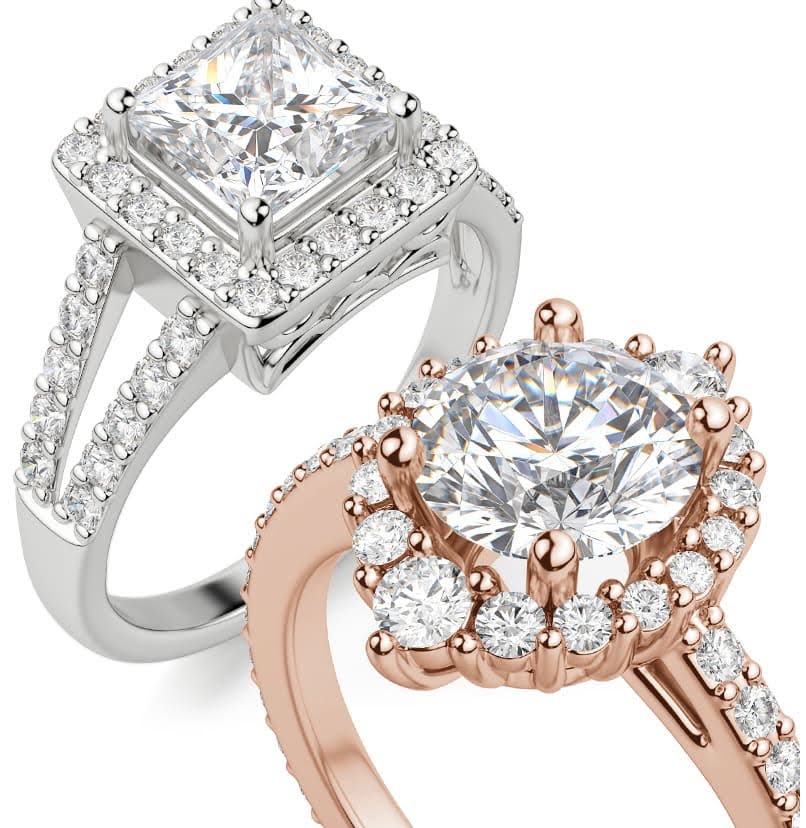Choosing the perfect diamond engagement ring is an exciting but often daunting task. When it comes to diamond cuts, two of the most popular choices are the round brilliant cut and the princess cut. Each has its unique characteristics and benefits, and understanding the differences can help you make an informed decision. Let’s dive in and explore what makes each cut special.
What Is a Diamond Cut?

The term “cut” refers to how the facets of a diamond are arranged during the cutting process. A high-quality cut enhances a diamond’s brilliance and sparkle, while a poor cut can diminish its beauty and value. Symmetry, proportion, and polish are crucial in achieving the best results.
What Is a Round Brilliant Cut Diamond?
If you’ve ever searched for “classic engagement rings,” you’ve likely seen many featuring a round brilliant cut diamond. This iconic cut accounts for about 60% of engagement ring and fine jewelry sales, and for good reason. The round brilliant cut is renowned for its exceptional brilliance and sparkle, thanks to its unique faceting pattern.

- History and Faceting: The round brilliant cut was first engineered in the 17th century with just 17 facets on the top of the gemstone. In 1919, it was refined to include 58 facets, creating the stunning diamond we know today.
- Sparkle and Concealment: This cut is excellent at concealing minor flaws in color and clarity, making small blemishes and inclusions less noticeable.
- Durability: Round brilliant diamonds have no edges or sharp corners, making them less vulnerable to snags, chips, and breaks. They are highly durable and perfect for everyday wear.
What Is a Princess Cut Diamond?
Princess cut diamonds are the second most popular choice, accounting for about 15% of diamond sales. They offer a modern, chic look and are known for their high sparkle and unique design.

- Shape and Faceting: Princess cut diamonds can be set in square or rectangular shapes, combining the best elements of the round brilliant and emerald cuts. They have 58 facets, similar to the round brilliant, but their square shape creates a distinct pattern of light and dark areas.
- Flaw Concealment: Like round brilliant cuts, princess cuts are relatively forgiving when it comes to hiding flaws and inclusions. However, be cautious of inclusions near the corners, as they can make the diamond more vulnerable to chipping.
- Protective Settings: To prevent damage, consider a protective bezel setting, which encircles the diamond with metal, providing extra security and protection.
Are Round Diamonds More Expensive Than Princess?
When it comes to cost, princess cut diamonds are generally more affordable than round brilliant cuts.
- Price and Yield: Carat for carat, a princess cut diamond will cost less than a round brilliant. This is because the princess cut creates less waste during the cutting process, resulting in a greater yield. Conversely, the round brilliant cut wastes over half of the rough diamond during the cutting process, driving up its price.
- Value for Money: For the same budget, you can get a larger princess cut stone compared to a round brilliant of comparable quality. This makes the princess cut a great value for those looking for a bigger diamond.

Size Perception
When comparing round and princess cut diamonds, there are a few surprises in terms of size perception.
- Optical Differences: A princess cut diamond will appear larger than a round brilliant of the same carat weight. This is due to the larger table (the top surface of the diamond) on the princess cut, which makes it look bigger to the naked eye.
- Visual Impact: The princess cut’s larger appearance adds to its modern and bold look, making it a popular choice for those who want a statement piece.
Popular Engagement Ring Settings
Both round and princess cut diamonds can shine in a variety of engagement ring settings. Here are some popular options:
Halo Setting
This setting encircles the center stone with smaller diamonds, making the main diamond look larger and more radiant. It’s a glamorous choice for both round and princess cut diamonds.

Solitaire Setting
A solitaire setting features a single diamond on a sleek metal band. It’s perfect for those who prefer a minimalist, elegant look.

Accented Setting
Opposite the solitaire is the accented engagement ring setting. In this style, a center stone is complemented by an accented band often featuring several small round cut stones to amp up the ring’s overall sparkle.

Prong Setting
The prong setting is simplistic in design and pairs well with almost all popular diamond shapes. In this style, a diamond is secured to the engagement ring or wedding band using either six or four prongs. Prong settings are a great option for stones with fragile corners or edges as the prong will give the stone some extra reinforcement and help prevent snagging or chipping.

Bezel Setting
The absolute best setting for fragile stones, the bezel setting is applauded for its ability to protect fancy shapes and regular stone shapes alike. In this style, the entire perimeter of the diamond is wrapped in metal to keep it in place. In addition to protection, there are visual reasons to choose a bezel setting too as it can give your ring a slightly vintage feel.
However, because the center stone is surrounded by metal, a bezel setting can impact your lab diamond’s light performance. But don’t worry too much about sparkle as diamonds receive most of their light from the top of the stone meaning that bezel set stones can still shine brightly.

Pavé Setting
This setting lines the ring’s band with small diamonds, adding extra sparkle to the center stone. It’s a luxurious choice but can be more expensive due to the additional diamonds.
Which Is Better: Princess Cut or Round Brilliance?
Ultimately, the best diamond cut depends on your personal preferences, lifestyle, and budget.
- Personal Taste: Consider the look you want to achieve. Do you prefer the classic elegance of a round brilliant or the modern chic of a princess cut?
- Lifestyle: If you have an active lifestyle, a round brilliant cut might be more durable and less susceptible to damage. If you want a larger-looking diamond, a princess cut could be the better choice.
- Budget: If you’re looking for a larger diamond within your budget, a princess cut offers great value. If you prioritize the ultimate in brilliance and timeless appeal, a round brilliant is hard to beat.
Conclusion
Both round brilliant and princess cut diamonds have their unique strengths and appeal. Whether you choose the classic elegance of a round brilliant or the modern brilliance of a princess cut, you’re sure to find a diamond that perfectly suits your style and needs. Consider the factors above to make the best choice for you and find the perfect engagement ring.








Leave a Comment